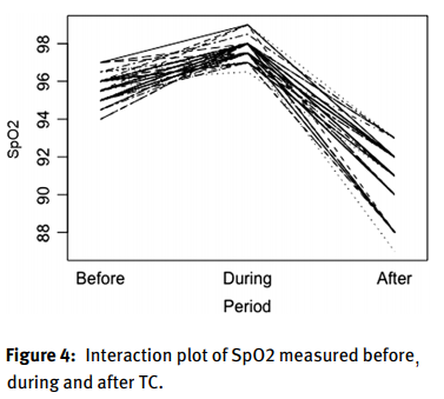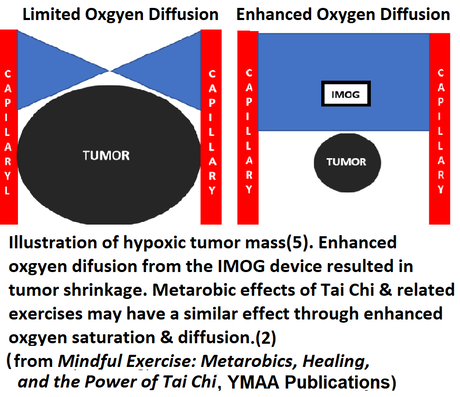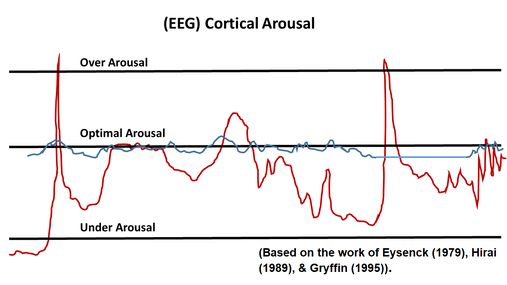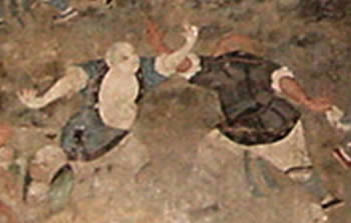Metarobic (or Metaerobic) Theory
 Gryffin PA, Diaz R. Effects of Tai Chi and Running on Blood Oxygen Saturation. Complement Integr Med 2021; aop. doi:10.1515/jcim-2020-0306
Gryffin PA, Diaz R. Effects of Tai Chi and Running on Blood Oxygen Saturation. Complement Integr Med 2021; aop. doi:10.1515/jcim-2020-0306
Metarobics is based on observations that mindful exercises focusing on relaxation and the breath (including tai chi, yoga and qigong) does not raise the heart rate to aerobic levels. This indicates that the benefits of these exercises may be due to a unique mechanism of action. Research supports a Metarobic response, a result of enhanced oxygen metabolism. Following is a brief overview of Metarobic theory.
For a more detailed understanding and overview of Metarobic theory and benefits, as well as over 50 case stories related to these exercises, please see Dr. Gryffin's book "Mindful Exercise: Metarobics, Healing, and the Power of Tai Chi."
For a more detailed understanding and overview of Metarobic theory and benefits, as well as over 50 case stories related to these exercises, please see Dr. Gryffin's book "Mindful Exercise: Metarobics, Healing, and the Power of Tai Chi."
 Gryffin PA. Mindful Exercise: Metarobics, Healing, and the Power of Tai Chi. YMAA Publications, August 2018.
Gryffin PA. Mindful Exercise: Metarobics, Healing, and the Power of Tai Chi. YMAA Publications, August 2018.
Overview of Metarobic Effects

The remarkable benefits reported by tai chi students with cancer and various chronic conditions prompted an examination of how and why these exercises might be providing benefits for health. The scientific literature is primarily focused on the benefits of Tai Chi, with little in the way of theory beyond “Qi” as “Vital Energy.”
This still leaves the question of how and why breath focused relaxation exercises might benefit health from a measurable physiological perspective. Research demonstrated a potential link between a unique effect on enhanced blood oxygen saturation, diffusion, and oxygen metabolism, as well as potential effects on hypoxia (deficiency of oxygen reaching the tissues). Hypoxia underlies or complicates a surprisingly wide range of chronic conditions, including cancer. But more research needs conducted in this area. Always talk with your doctor before making any changes to your health routines or treatment.
This still leaves the question of how and why breath focused relaxation exercises might benefit health from a measurable physiological perspective. Research demonstrated a potential link between a unique effect on enhanced blood oxygen saturation, diffusion, and oxygen metabolism, as well as potential effects on hypoxia (deficiency of oxygen reaching the tissues). Hypoxia underlies or complicates a surprisingly wide range of chronic conditions, including cancer. But more research needs conducted in this area. Always talk with your doctor before making any changes to your health routines or treatment.
Preliminary research uncovered a potential link related to possible effects on hypoxia (oxygen deficiency), which underlies or complicates a wide range of chronic conditions. Further measurements showed the largest increase in blood oxygen saturation and diffusion occurred during more stationary movements, such as “grasp the bird’s tail” in tai chi, and the standing movements of paduanjin (eight pieces of silk qigong).
Aerobic exercises resulted in either no change or a drop depending on intensity. However, walking, when combined with a focus on relaxation and the breath, resulted in a statistically significant increase. All increases and decreases in blood oxygen saturation were significant (p < 0.001), with the exception of normal walking.
What is most notable, is the 5-10 point drop in blood oxygen saturation following tai chi practice, which supports potential enhanced metabolic function and oxygen use in the body during tai chi and related mindful exercises. See “Mindful Exercise: Metarobics, Healing, and the Power of Tai Chi" for additional diagrams and information and the relevance to chronic conditions, as well as supporting case stories.
Aerobic exercises resulted in either no change or a drop depending on intensity. However, walking, when combined with a focus on relaxation and the breath, resulted in a statistically significant increase. All increases and decreases in blood oxygen saturation were significant (p < 0.001), with the exception of normal walking.
What is most notable, is the 5-10 point drop in blood oxygen saturation following tai chi practice, which supports potential enhanced metabolic function and oxygen use in the body during tai chi and related mindful exercises. See “Mindful Exercise: Metarobics, Healing, and the Power of Tai Chi" for additional diagrams and information and the relevance to chronic conditions, as well as supporting case stories.
Tai Chi as a Mindfulness Based Practice.
 Effects of Tai Chi as a Mindfulness Based Practice on EEG Waves.
Effects of Tai Chi as a Mindfulness Based Practice on EEG Waves.
Aside from benefits for health and chronic conditions, Metarobic exercises can benefit psychological health as a mind/body practice. Mindfulness Meditation as, popularized by Jon Kabat-Zinn, is aimed at transforming behavior through enhanced non-judgmental in-the-moment awareness. As a form of moving meditation and mindfulness based practice, tai chi can help develop greater self-understanding, focus and sense of calm.
Meditative practices can also create a subtle shift in mental function, with measurable changes in brain (EEG) waves (see chart). The red line is the EEG waves of an untrained mind (simplified for illustration). Throughout the day it shoots up and down, like a roller coaster, in response to various stimuli.
Zen training helps the mind to stay at optimal arousal (the blue line), focused and ready for action, inspiration, and interaction. Tomio Hirai found that the EEG waves of Zen monks would actually “flat line” during mediation. Researchers had never seen this before, and had to come up with a new term, “brain trains,” rather than “brain waves.”
Mindfulness can also help with addiction to drugs, alcohol, and tobacco, as well as to self-destructive behaviors (such as various forms of self-sabotage). It can also help with diet (increasing awareness of what we eat, when we eat, and why we eat). Much of eating is a stress reaction. Hence “comfort food."
Elements of Mind/Body training, rooted in Zen practice, includes Mushin (No-Mind), which in East-West psychology can be translated as mindfulness from “emptiness.” The idea is that to become mindful, you first have to become an empty vessel (a great tool for dealing with past trauma and abuse). It is easier to not be haunted or tormented by the past, if you live in the moment (i.e. “mindful”), empty of the past. Other critical concepts include developing control of the “Monkey Mind” (random and destructive thoughts), and superior focus (Isshin, One Mind), as paths to Kensho (Self-Nature/Self-Realization). Essentially using a physical practice to train the mind. As such, exercises such as tai chi are ideal for this.
Being focused on the leading hand, similar to focal points used in sitting meditation, creates a state of “Mushin” or “No Mind,” during which here is no sensation of the passage of time, and no element of boredom (a common complaint among beginning meditators). Empty of “self,” one is filled with a sense of peace and well-being.
For a fun and inspirational journey into these arts as a mind/body practice to develop reliance and self-understanding, please see my book Journey to the East: An Experiential Book - Special Edition. This book is based on my experiences and those of my teachers, set in turn of the century China, and includes a workbook in the appendix. Joseph Girzone, the author of the best-selling book, and movie of the same name, Joshua: A Parable for Today, noted of my book: "The message is rich and much needed today. I have never seen such a strong and healthy case for the ascetical side of spirituality described in such a fascinating and enjoyable way as you have in this book."
For information on using Tai Chi as a Mindfulness Based Practice for Smoking Cessation, see: Gryffin PA, Chen WW. Implications of t’ai chi for smoking cessation. Journal of Alternative and Complementary Medicine. 2012; 18(6): 1-5.
Other forms of Mind/Body Training

The focus of the Metarobics.org is on exercises such as tai chi. However, the above elements also apply to other traditional martial arts (tai chi originated as a form of kung fu), which can also be used as a form of Mind/Body training. According to legend, martial training through forms of kung fu, as a mind/body practice rooted in Zen (Chan), originated at the Shaolin monastery 1500 years ago. The father of Zen (Bodhidharma) is credited with stating: “To train the mind, one must first train the body.”
Elements of tai chi and kung fu, as forms of mind/body training, will be touched on periodically on the Metarobics Mind/Body News page.
Elements of tai chi and kung fu, as forms of mind/body training, will be touched on periodically on the Metarobics Mind/Body News page.